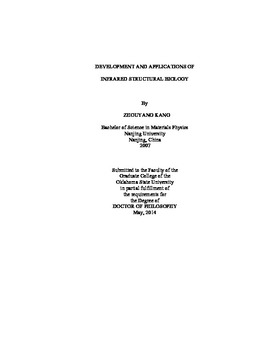| dc.contributor.advisor | Xie, Aihua | |
| dc.contributor.author | Kang, Zhouyang | |
| dc.date.accessioned | 2015-06-17T20:06:32Z | |
| dc.date.available | 2015-06-17T20:06:32Z | |
| dc.date.issued | 2014-05 | |
| dc.identifier.uri | https://hdl.handle.net/11244/14927 | |
| dc.description.abstract | Aspartic acid (Asp), Glutamic acid (Glu) and Tyrosine (Tyr) often play critical roles at the active sites of proteins. Probing the structural dynamics of functionally important Asp/Glu and Tyr provides crucial information for protein functionality. Time-resolved infrared structural biology offers strong advantages for its high structural sensitivity and broad dynamic range (picosecond to kilosecond). In order to connect the vibrational frequencies to specific structures of COO- groups and phenolic -OH groups, such as the number, type, and geometry of hydrogen bond interactions, we develop two sets of vibrational structural markers (VSM), built on the symmetric and asymmetric stretching frequencies for COO- and C-O stretching and C-O-H bending frequencies for phenolic -OH. Extensive quantum physics (density functional theory) based computational studies, combined with site-specific isotope labeling as well as site-directed mutagenesis, and experimental FTIR data on Asp/Glu in proteins, are used to establish a unique correlation between the vibrations and multiple types of hydrogen bonding interactions. Development of those vibrational structural markers significantly enhances the power of time-resolved infrared structural biology for the study of functionally important structural dynamics of COO- from Asp/Glu and phenolic -OH from Tyr residues in proteins, including rhodopsin for biological signaling, bacteriorhodopsin and PYP for proton transfer, photosystem II for energy transformation, and HIV protease for enzymatic catalysis. Furthermore, this approach can be adopted in the future development of vibrational structural markers for other functionally important amino acid residues in proteins, such as arginine (Arg), histidine (His), and serine (Ser). | |
| dc.format | application/pdf | |
| dc.language | en_US | |
| dc.rights | Copyright is held by the author who has granted the Oklahoma State University Library the non-exclusive right to share this material in its institutional repository. Contact Digital Library Services at lib-dls@okstate.edu or 405-744-9161 for the permission policy on the use, reproduction or distribution of this material. | |
| dc.title | Development and applications of infrared structural biology | |
| dc.contributor.committeeMember | Mintmire, John W. | |
| dc.contributor.committeeMember | Zhou, Donghua H. | |
| dc.contributor.committeeMember | Hoff, Wouter D. | |
| dc.contributor.committeeMember | Soulages, Jose L. | |
| osu.filename | KANG_okstate_0664D_13394.pdf | |
| osu.accesstype | Open Access | |
| dc.type.genre | Dissertation | |
| dc.type.material | Text | |
| dc.subject.keywords | density functional theory | |
| dc.subject.keywords | hydrogen bond | |
| dc.subject.keywords | infrared spectroscopy | |
| dc.subject.keywords | isotopic labeling | |
| dc.subject.keywords | vibrational frequency | |
| dc.subject.keywords | vibrational structural marker | |
| thesis.degree.discipline | Physics | |
| thesis.degree.grantor | Oklahoma State University | |
